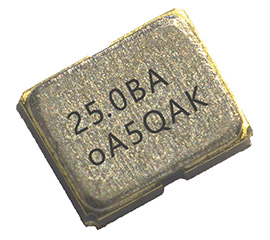Epson Now Shipping Samples of New SPXOs for Automotive Applications
- Excellent stability and jitter performance make SG-8201CJA ideal for LiDAR and ADAS electronic control units -
- TOKYO, Japan, May 24, 2022 -
Seiko Epson Corporation (TSE: 6724, "Epson") has begun shipping samples of the SG-8201CJA, a new addition to Epson's lineup of crystal oscillators (SPXO) with CMOS output1 for automotive applications. Offering high stability and low jitter2, the SG-8201CJA is a simple packaged SPXOs that typically measures 2.0 mm x 1.6 mm x 0.6 mm.

Applications in autonomous driving (AD), such as light detection and ranging3 (LiDAR) and vehicle cameras in advanced driver-assistance systems (ADAS) require a reference clock with a frequency in the 100 MHz range due to the high radio frequencies and high-speeds handled. Moreover, improvement in AD and ADAS performance has fueled rising demand for clocks that offer excellent stability and jitter performance. Demand is also strong for smaller products in all automotive applications.
Like its predecessor, the SG-8101CGA, the new crystal oscillator supports output frequencies as high as 170 MHz for automotive applications, but it has 50% better frequency tolerance and approximately 1/25th the phase jitter. The package footprint and cubic volume are also 64% and 55% smaller, respectively. AEC-Q1004 compliant, the SG-8201CJA operates at ambient temperatures up to 125℃ as required for automotive applications and contributes to automotive safety and reliability.
Epson has also started shipping samples of the SG-8200CJ and SG-8201CJ crystal oscillators for industrial and consumer applications. With this, Epson has assembled a lineup of products for applications in the consumer, commercial, industrial, and automotive segments.
Epson seeks to leverage its device technologies to realize a smart society. Toward this end, the company will continue to develop products for automotive applications in which uncompromising accuracy and safety features are demanded and that enhance the performance of our customers' products.
Product features
AD and ADAS-related features (e.g., LiDAR and vehicle cameras)
Related links
Please see the link below for product details.
Website URL: https://www.epsondevice.com/crystal/en/products/crystal-oscillator/sg8201cja.html
Product specifications
| Model No. | SG-8201CJA |
|---|---|
| Output type | CMOS |
| Output frequency range | 1.2 MHz to 170 MHz |
| Supply voltage | 1.62 V to 3.63 V |
| Frequency tolerance5 / operating temperature | ±15 x 10-6 / -40℃ to +105℃ ±25 x 10-6 / -40℃ to +125℃ ±50 x 10-6 / -40℃ to +125℃ |
| Current consumption (no load) | 7.5 mA Max. (fo = 25 MHz) 12.4 mA Max. (fo = 125 MHz) |
| Phase jitter (12 kHz to 20 MHz) | 1.1 ps Typ. (fo = 125 MHz) |
| Standard compliance | AEC-Q100 |
| Dimensions | 2.0 mm x 1.6 mm x 0.6 mm, Typ. |
1 CMOS output: The output of a semiconductor device (a complementary MOS) that consists of a complementary combination of P-type and N-type MOSFETs. Widely used in digital circuits, the H level is output as the power supply voltage and the L level is output as the ground potential.
2 Jitter: Fluctuations in the clock period that can cause things such as fluctuations in displayed images and bit errors in data transmissions.
3 LiDAR: Technology in which a sensor emits pulsed laser light waves that bounce off surrounding objects and return to a receiver. The sensor is able to measure the distance to objects and instantaneous velocity based on the time it took for each pulse to return
4 AEC-Q100: The Automotive Electronics Council (AEC) is an industry group that creates standards for the reliability and qualification of automotive electronics. It was formed by the "Big Three" U.S. automobile manufacturers in partnership with major electronic component manufacturers. The AEC standard is a de facto global standard that has been widely adopted as a standard for automotive electronic components.
5 Including frequency tolerance, frequency/temperature coefficient, frequency supply voltage variation characteristics, frequency load variation characteristics, reflow characteristics, and frequency aging (+25℃, 1 year)
About Epson
Epson is a global technology leader dedicated to co-creating sustainability and enriching communities by leveraging its efficient, compact, and precision technologies and digital technologies to connect people, things, and information. The company is focused on solving societal issues through innovations in home and office printing, commercial and industrial printing, manufacturing, visual and lifestyle. Epson will become carbon negative and eliminate use of exhaustible underground resources such as oil and metal by 2050.
Led by the Japan-based Seiko Epson Corporation, the worldwide Epson Group generates annual sales of more than JPY 1 trillion.
corporate.epson/en/


